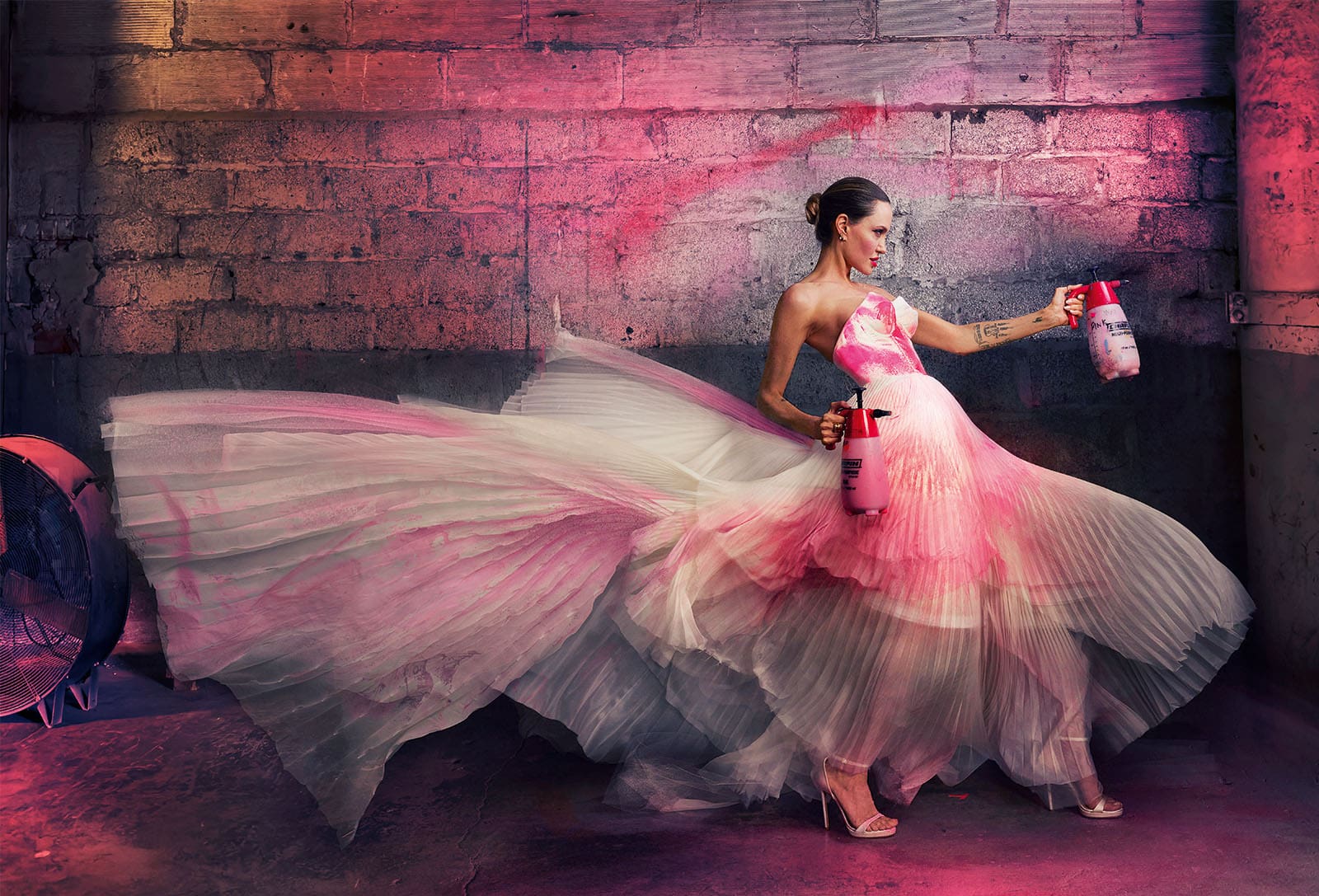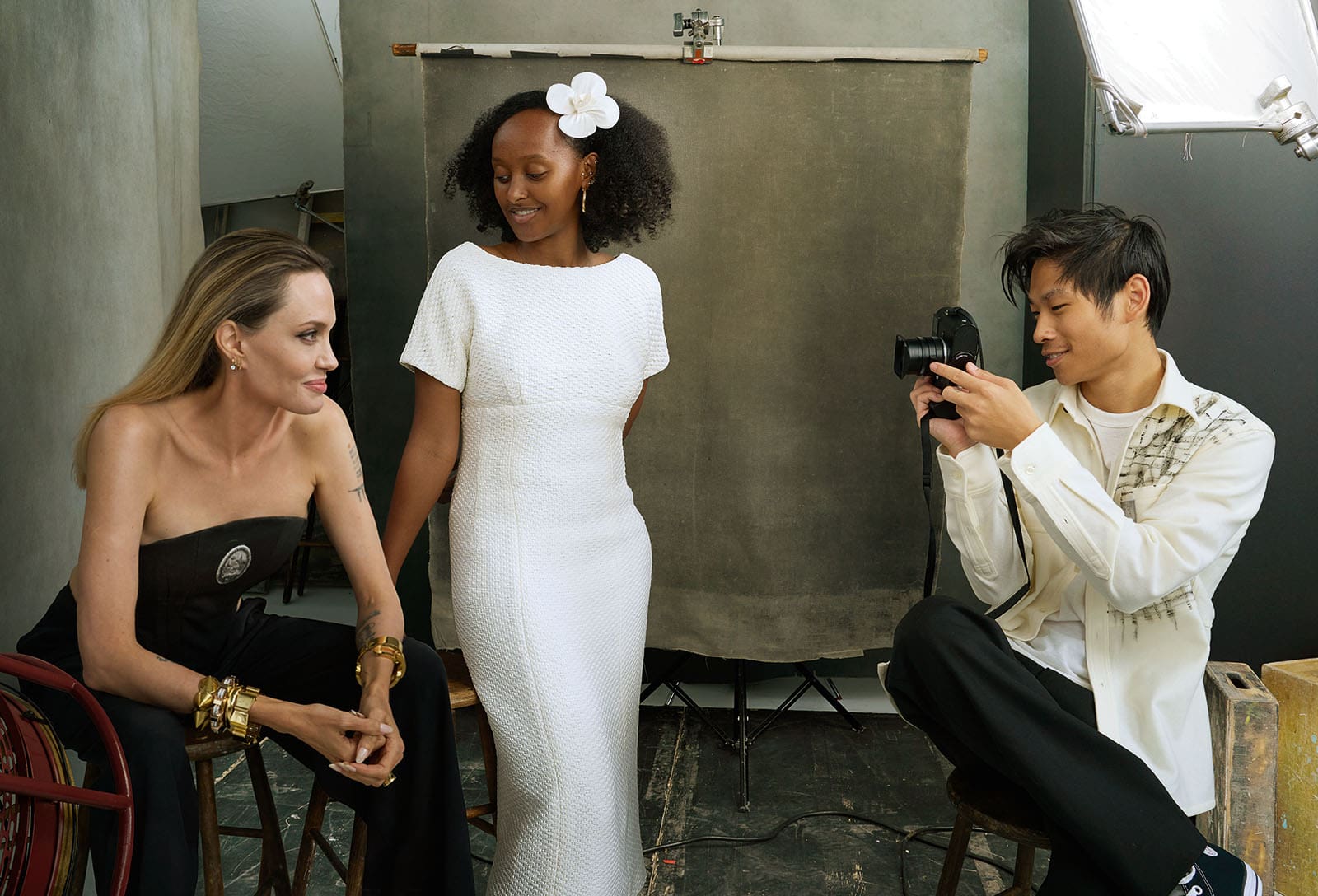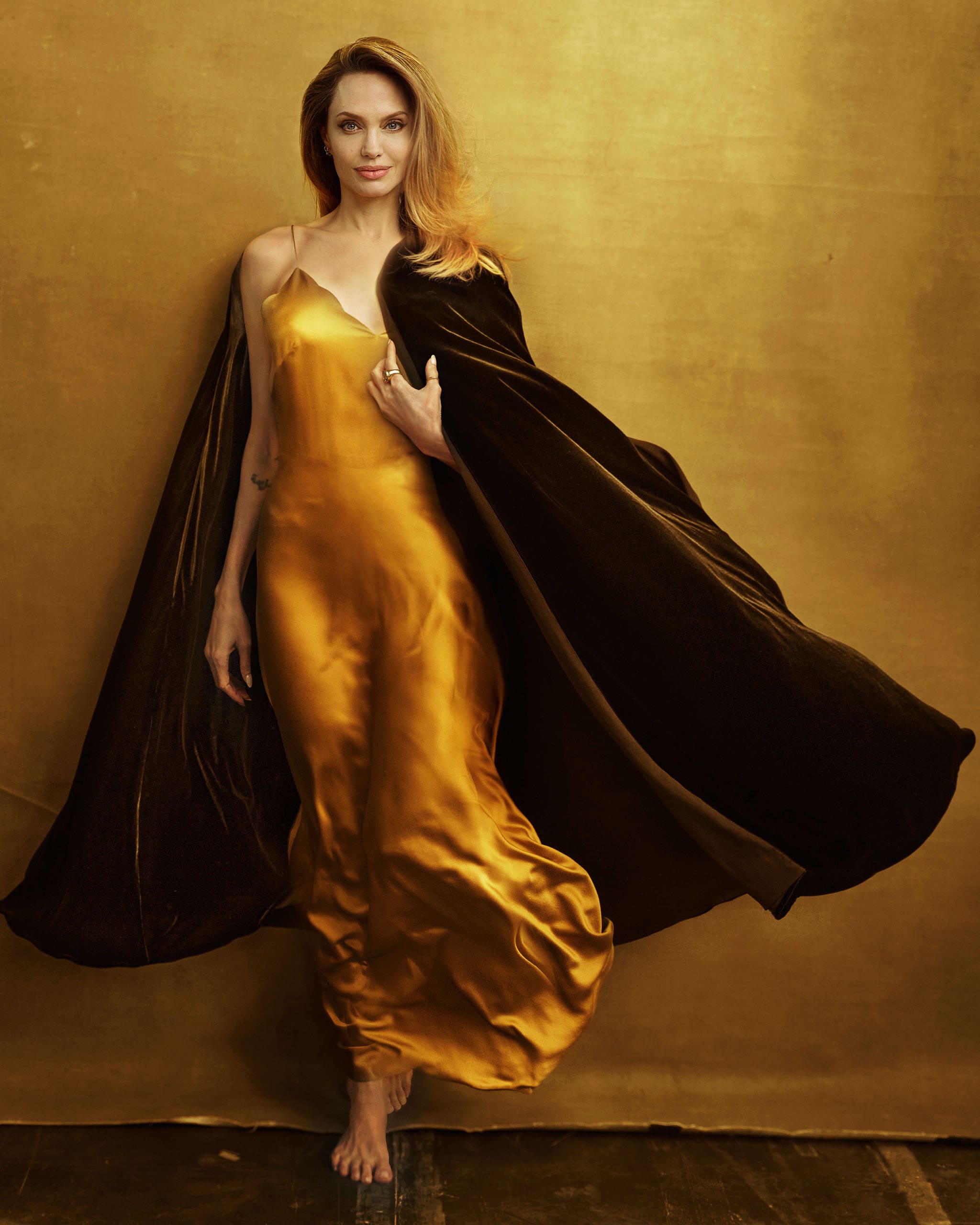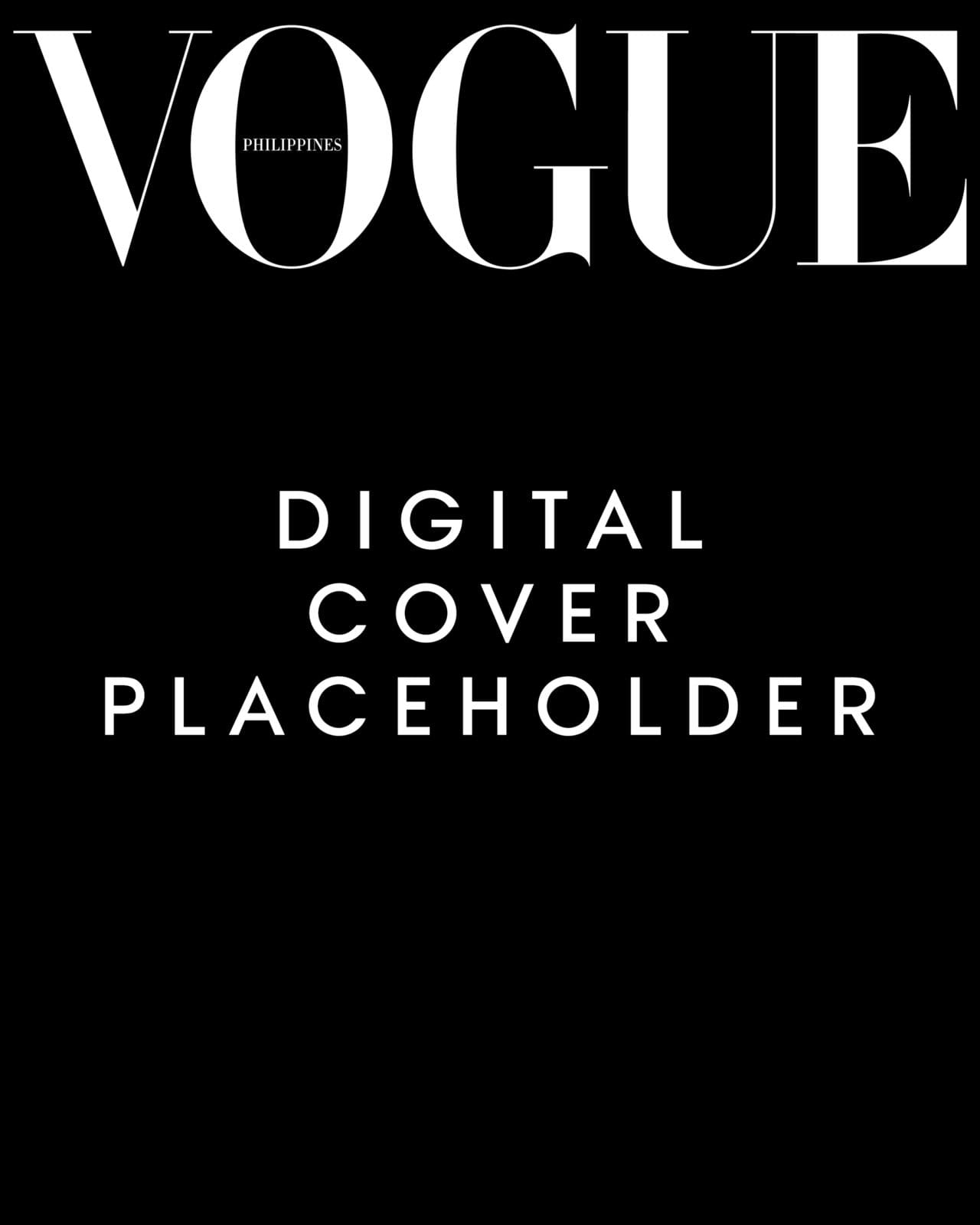GOING FOR GOLD. Angelina Jolie, wearing a lower-impact silk slip dress and velvet cape from Chloé x Atelier Jolie; Chloé SoHo boutique. Fashion Editor: Tabitha Simmons. Produced by AL STUDIO. Set design by MARY HOWARD
Angelina Jolie has always done things her way. Is it any surprise, then, as Chioma Nnadi discovers, that she’s shaking up the world of fashion?
Among downtown New York art aficionados, 57 Great Jones Street is something of a sacred site. Andy Warhol bought the two-story building in 1970, famously renting the second floor to his friend Jean-Michel Basquiat a decade later, shortly after they met. And now, with the façade almost completely covered in graffiti, it seems as if every street artist within a 30-mile radius has paid homage. “Perhaps we can do something with all the art,” says Angelina Jolie, peering out from under her enormous umbrella. It’s a drizzly Sunday morning in mid-July, and she’s fresh off the plane from Italy. Six months ago, she and her eldest daughter, Zahara, 18, a student at Spelman College in Atlanta, stumbled upon this place while hunting for downtown retail spaces. The moment they walked through the door, they knew the search was over. “I can be very impulsive, but Zahara is so grounded, decisive, and thoughtful,” Jolie says. “When she agreed, I felt we were both decided.”
This month, the actor, director, and former UN Refugee Agency Goodwill Ambassador and Special Envoy will open the doors on Atelier Jolie, a somewhat broadly defined effort to bring her globally minded, socially conscious values to the world of fashion. She envisions it as a space of collaboration, a kind of cultural-center–meets–design workshop that combines tailoring and upcycling services with a gallery space for local artisans and a café run in partnership with refugee organizations. “I’ve met a lot of artisans over the years—very capable, talented people—and I’d like to see them grow,” Jolie says as she gives me a tour of the space before the contractors go to work. Her list of collaborators includes the London-based milliner Justin Smith and South African lacemaker Pierre Fouché—but, she says, “it’s not really about fashion.” Nor is Atelier Jolie about her, she is quick to add. “I don’t want to be a big fashion designer. I want to build a house for other people to become that.” Jolie’s goal is to create community, and in that sense, her project breaks the traditional celebrity mold—one that often amplifies the cult of its founder’s personality. Atelier Jolie’s model is perhaps best compared to the Olsen twins’ The Row, where fame doesn’t overshadow the clothes, or undervalue the commitment.
Our tour begins on the second floor, a light-filled loft furnished with high ceilings, exposed rafters, and benches of reclaimed wood where soon a team of tailors will set up shop with deadstock and artisanal fabrics. Jolie herself is modeling a pair of custom woolen gray trousers, one of multiple styles that will be available made to measure; the cost of a custom slip, say, will start around $300, with repair services that begin at $10 for a hand-painted patch. There will also be take-home mending kits and a stud-it-yourself activity station in the café that patrons can use for free.

Though the property has passed through several hands since Basquiat lived here, traces of the prolific artist remain: the graffiti tag SAMO© (pronounced same-oh)—something he coined with his friend Al Diaz—is scrawled on the concrete floor. This morning, Jolie has her own small crew in tow: the brand’s president and chief operating officer, Helen Aboah, and Giles Duley, who is advising the project on corporate impact but started his career as a music photographer, soon evolving into “an angry man with a camera,” he says, with a focus on the impact of conflict on communities around the world. “Over the last 20 years documenting humanitarian stories, I’ve seen the negative impact of Western consumerism on developing countries—from child labor, illegal extraction of minerals, pollution from the dyeing of fabrics, exploitation of farmers, and much more,” he says. “Atelier Jolie can have an incredible positive impact on artisans who have often been unrecognized and undervalued—but we also have an opportunity to start conversations about workforce exploitation, pollution, and waste.” Adds Aboah: “At the top of Angelina’s manifesto is also the idea that we are all creators.”
There are signs that the team is beginning to make its mark: Draped over the doorway is a blank canvas stenciled with the Atelier Jolie logo in white spray paint. “That was my son practicing,” Jolie says proudly of Pax, 19, who along with Zahara has been heavily involved with Atelier Jolie. As a single mother of six, Jolie considers major endeavors such as this one a project for the entire family, and she turns both expansive and personal on the subject when the conversation turns to her children. “I was 26 when I became a mother,” she tells me. “My entire life changed. Having children saved me—and taught me to be in this world differently. I think, recently, I would’ve gone under in a much darker way had I not wanted to live for them. They’re better than me, because you want your children to be. Of course I’m the mother, and hopefully that safe place for them and that stability. But I’m also the one that they laugh at—and I see them taking over so many different aspects of our family.”
On our way downstairs, she and Duley decide to stage a kind of DIY art experiment: Jolie is swaddled today in one of her signature cream-colored trench coats—by the sustainable brand Another Tomorrow—but she promptly peels it off in a brightly lit corner of the ground floor studio. “We’re trying to see if we can take photographs of tattoos,” she says, “and turn them into patches—the idea is to make your clothing your own, instead of simply getting rid of it.” She turns her back to Duley’s camera and strips to the waist, revealing her dense lattice of body art. Aboah and I move toward the door, quickly engaging in small talk in an effort to give Jolie privacy. But the movie star in the room seems unfazed.
The tattoos that trace Jolie’s delicate frame include a phrase in Arabic running along her right arm, translating to “strength and hope,” and another in Italian—“still it moves,” a phrase famously attributed to Galileo after his revelatory scientific observations on the solar system landed him in court. “My kids would roll their eyes if they were here,” Jolie says. “I was quite dark when I was young. I was a punk, not the popular kid—going to thrift stores, cutting things up, burning little teeny cigarette holes into things: That was me as a teenager, and I wouldn’t trade it for the world. Maybe that part of me wants to push back.”
For someone raised on rebellion, Jolie’s mode of dressing tends toward the minimalist and monochromatic, with a distinctly restrained and conservative bent. As a woman who’s been deeply involved with humanitarian causes for decades, she’s clearly worked hard to keep the focus on what she’s doing, not what she’s wearing. She prefers to shop for herself and work with tailors rather than celebrity stylists. “There are more books than clothes in my closet,” she allows. “I’m not someone who likes clothes to consume her life. And I don’t love the idea of being ‘influenced.’”
Though she’s loath to admit it, her approach to fashion has been hugely influential. Each style move she makes is fastidiously anatomized by fans on social media, and her seeming reluctance to make a spectacle of herself has only contributed to the current yen for all things quiet luxury (see also Gwyneth Paltrow’s 2023 courtroom style and the character Shiv Roy in Succession). These days a fashion website that successfully identifies Jolie’s choice of a seemingly unremarkable airport shoe can drive hundreds of thousands of clicks. And it’s precisely that power that Jolie is hoping to harness for good.
“I think part of this has been therapeutic for me—to work in a creative space with people you trust and to rediscover yourself.”
“I find it slightly funny that we are involved in fashion—I don’t think any one of us is overly ‘fashionable,’” she says, referring to both herself and her children. “But because we live in our clothes, it is so much a part of who we are, and something that’s important to explore, especially for young people.” The atelier is exactly the kind of place she’d like to go to with her kids. “I’ve always wanted to take my family to a place where I can say: Does your clothing really represent you? Absolutely you? And do you love it? I think the average person would not think it does. But I think tailoring does that for you.”
As Jolie tells it, the concept for her new project was born out of a desire to address conversations around self-presentation and identity head on. She recalls one such pivotal family discussion surrounding the Los Angeles premiere of her Marvel movie Eternals back in 2021. “I don’t tell the kids how to dress,” she says. “Even when they were little, I just put things in front of them.” The same goes for public appearances: “Nobody has to go anywhere if they don’t want to, and if they don’t want to dress up, they don’t have to.” On this particular occasion, five of her kids did—enthusiastically—dress up. And so Jolie decided to make their red carpet appearance an experiment in circular fashion, gathering pieces from her closet and letting her children choose. In the pile: a beige box-pleated Gabriela Hearst dress that Shiloh, then 15 and known for her smart suiting and boyish haircuts, opted to wear youthfully tailored to the knee. Zahara, meanwhile, selected a dazzling beaded Elie Saab dress from her mother’s storage, first seen at the Oscars in 2014. “I went vintage shopping with a few of them as well—I think Knox was wearing all vintage. The cut was quite unusual, quite cool, I thought,” says Jolie of her youngest son, then 13. “I want them to be their own people.”
Later that morning, Jolie decides to pay Gabriela Hearst a visit and invites me to tag along. The pair have collaborated on a capsule collection with Chloé, consisting of evening wear directly inspired by Jolie’s quietly sophisticated sensibilities, and Jolie is eager to tell me more about it. For Hearst, whose three-year tenure as creative director at Chloé ends this season, the project is somewhat of a last hurrah. “I didn’t realize just how few B Corp fashion companies there are out there aside from Chloé,” she says with a sigh as we ride over to Hearst’s studio in Chelsea. (B Corp certification is awarded to companies that meet high standards of social and environmental impact.) “Gaby’s worked really hard,” Jolie adds. “It’s no small feat.” She’s not wrong: Thanks to Hearst, the French house became, in 2021, the first luxury fashion brand to earn B Corp status. Having seen the effects of climate displacement firsthand, Jolie takes that achievement seriously. She parted with the UNHCR last December, and is clearly looking to explore new, more immediate ways to make a meaningful contribution. “I’ve spent over 20 years of my life working on foreign policy, and aid relief, and displacement, and laws pertaining to refugees, and I kept watching the same situation get worse and the same cycles continue,” she explains. “Now I want to shift the focus and look at how we can work in partnership with people around the world to bring not just skills training, but actual business partnership. I don’t really believe the current system is working.” Hearst sees potential in the partnership too. “I admire people who use their spotlight to illuminate those who need it,” says Hearst, who was introduced to Jolie via a mutual friend a couple of years back. “And she’s the epitome of that.”
In person, the pair have the easy rapport of old friends. They settle into Hearst’s cozy office with cups of green tea, and their conversation turns playful. “Remember when we had that hilarious Zoom call?” says Jolie. “We were both half naked, trying clothes on for each other.” Jolie takes out her phone to find the evidence. “I had wine,” says Hearst with a grin. “Looks like a lot of weird freeze-frames here,” Jolie says, scrolling through her saved photos. “No, wait—I think it’s this one!” On her screen: a woozy shot of a half-dressed Hearst. The designer blushes, and the two erupt in fits of laughter.
Jolie produces another image on her phone, this one a childhood photo of her with her mother, the actor Marcheline Bertrand, who died in 2007 at the age of 56 after an eight-year battle with ovarian and breast cancer. Jolie the toddler is dressed in a tiny black velvet cape and an adorable hand crocheted white smock. “That was my very first cape,” she says, fondly. “My mother was a hippie—she called herself that, she was very proud. She didn’t shop a lot. She loved her velvets and her suedes. She never wore makeup, nor did she really do her hair. She wasn’t a flashy person—she was elegant, natural.”
This sweet mother-daughter portrait was a jumping-off point for the Chloé collaboration, one that sparked a larger conversation between the two women. “Angelina and I are basically the same age,” Hearst says, “and then I learned that her late mom would have been the same age as my mom now.” A black-and-white photograph of Hearst’s mother—a Buddhist, taekwondo master, and fifth-generation Uruguayan cattlewoman—is propped up on the desk behind her. “So I started researching Angelina’s mom: her beauty, her strength, and her grace.”

The capsule includes a dramatic floor-length velvet cape, and an adult-size version of Jolie’s baby crochet smock handmade by the crafts people at La Fabrique Nomade, an organization in Paris that works with refugees. Jolie’s trademark silk slip dress emerges through a broad range of nude shades—the suggestion of Zahara, who has struggled to find the right match for her dark brown skin tone. “Obviously, as a white woman, I’ve never had this experience,” Jolie says, candidly. “It never crossed my mind until we went shopping together and I saw that there’s so much room for improvement.” (A full 84 percent of the collection is made using sustainable and ethical materials.)
There’s plenty of tailoring to be found here too—a nip-waisted black coat cut from organic silk gazar is a standout—though overall, the look is gently rounded, not rigorous, all soft shoulders and curvilinear shapes. “Sometimes the way you dress says, ‘Don’t mess with me—I’ve got my armor on,’ ” says Jolie. “But I want a woman to feel safe enough that she can be soft. After I went through something where I was hurt, I had a therapist ask if I would try wearing a flowing garment. Sounds silly, but I assumed that pants and boots projected a ‘tougher’ look, a stronger me. But was I strong enough to be soft? At the time, no. I felt vulnerable. Now I wonder if I don’t know what my style is because I’m still understanding who I am at 48. I guess I’m in transition as a person.” She pauses to gather her thoughts. “I feel a bit down these days. I don’t feel like I’ve been myself for a decade, in a way, which I don’t want to get into,” she says, perhaps alluding to the intense public scrutiny she has faced around her difficult and drawn out divorce from Brad Pitt. She adds that she started doing less film work “seven years ago, only taking jobs that didn’t require long shoots. We had a lot of healing to do. We’re still finding our footing.” Atelier Jolie is part of this process, it seems. “I think part of this has also been therapeutic for me—to work in a creative space with people you trust and to rediscover yourself,” she says. “I’m hoping to change many aspects of my life. And this is the forward-facing one.”
Around lunchtime, Jolie gets a call from her driver: It seems she is running late for a rendezvous with Pax—they’re on the hunt for New York apartments. (Jolie has just signed on to produce The Outsiders on Broadway.) Jolie turns to hug Hearst goodbye. “I’m not really somebody that has girlfriends, so this has been an interesting jump for me,” she says. Hearst returns the embrace and sends Jolie off with her favorite single-origin fair trade bar from Dick Taylor Craft Chocolate.
The next morning, at a photo studio in Brooklyn with Annie Leibovitz, glimpses of Jolie’s free-spirited and rebellious side come into view. The atelier founder has decided that a pristine white knife-pleated dress she’s had custom made for the shoot is far too plain. What it lacks, she insists, is a personal touch, maybe some graffiti. She grabs a bottle of hot pink spray paint in each hand and gets to work.

